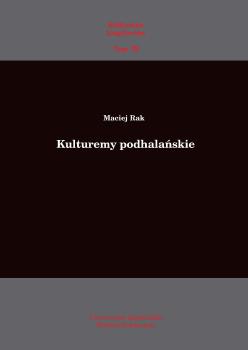Kulturemy podhalańskie
Keywords:
badania językoznawcze, leksyka podhalańska, dialektologiaSynopsis
PODHALE CULTUREMES
Dialectologists interested in lexis gathered their resources in the form of dictionaries, subdialect texts and atlases, while ethnolinguists dealt with linguistic picture of the world as present in subdialect material. And in such a way was the Podhale subdialect described. However, these works fail to answer the following question – which words are particularly important for Podhale Gorals (highlanders)? It is a question of ethnolinguistics (to be exact – of ethnosemantics), and the answer is contained in the present monography. The concept of a cultureme has been used in translation studies, stylistics, and ethnolinguistics. In the last conceptualization (represented by Alicja Nagórko) a cultureme is closest to Anna Wierzbicka’s key words. Culturemes might be identified as key words important for a community’s self-awareness. Surveys, analyses of printed texts and Gorals’ utterances were used to identify Podhale culturemes. The researcher’s intuition played an important role. As a result, 34 culturemes were determined. Understanding these units is a key to understanding Podhale culture.
Chapters
-
TABLE OF CONTENTS
-
Wprowadzenie .......... 7
-
1. ROZSTRZYGNIĘCIA TERMINOLOGICZNO-METODOLOGICZNE .......... 11
-
1. Co to jest kulturem? .......... 11
-
2. Inne pokrewne koncepcje .......... 14
-
3. Metody typowania kulturemów .......... 18
-
4. Sposób opisu (eksplikowania) kulturemów .......... 31
-
2. CHARAKTERYSTYKA OBSZARU BADAŃ I MATERIAŁU .......... 35
-
1. Podhale jako teren badań .......... 35
-
2. Kompozycja pracy .......... 40
-
3. Pochodzenie materiału .......... 41
-
3. SWOI I OBCY .......... 47
-
1. Górál .......... 47
-
2. Gazda .......... 63
-
3. Baca .......... 69
-
4. Juhas .......... 84
-
5. Zbójnik .......... 95
-
6. Ksiondz .......... 120
-
7. Pán .......... 126
-
8. Ceper .......... 135
-
4. WARTOŚCI .......... 135
-
4.1. Wartości pozytywne .......... 142
-
1. Pámbócek.......... 146
-
2. Pániezus .......... 158
-
3. Gaździná Podhála .......... 165
-
4. Krzýz .......... 171
-
5. Śleboda .......... 179
-
6. Honór .......... 188
-
7. Robota .......... 195
-
8. Ziym .......... 210
-
9. Dudki .......... 224
-
4.2. Wartości negatywne .......... 238
-
1. Biyda .......... 239
-
2. Głód .......... 251
-
5. TOŻSAMOŚĆ KULTUROWA .......... 261
-
1. Gwara .......... 264
-
2. Muzýka .......... 264
-
3. Śpiywanie .......... 277
-
4. Tániec .......... 286
-
5. Ubranie .......... 295
-
6. Portki .......... 299
-
7. Ciupaga .......... 307
-
8. Moskál .......... 315
-
9. Oscypek .......... 321
-
10. Gorzáłka .......... 328
-
11. Owca .......... 338
-
6. GEOGRAFIA MENTALNA .......... 347
-
1. Podhále .......... 351
-
2. Góry .......... 356
-
3. Giewont .......... 362
-
4. Hála .......... 368
-
Podsumowanie .......... 375
-
Aneks .......... 379
-
Literatura .......... 379
-
Indeks osób .......... 421





